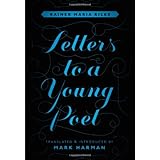
Average Reviews:

(More customer reviews)Are you looking to buy Letters to a Young Poet? Here is the right place to find the great deals. we can offer discounts of up to 90% on Letters to a Young Poet. Check out the link below:
>> Click Here to See Compare Prices and Get the Best Offers
Letters to a Young Poet Review"Letters to a Young Poet," newly translated by Mark Harman and published by Harvard University Press, is one of only three hardback editions solely devoted to Rilke's ten letters to Franz Kappus. One, with a translation by Joan M. Burnham (Letters to a Young Poet), has been criticized for compromising the beauty of Rilke's prose. The other is a Modern Library edition featuring a widely praised translation by Stephen Mitchell, which you can find at this link: Letters to a Young Poet (Modern Library). Both Harman and the elder Mitchell are well respected for their craft. From what I've read of reviewers who understand the nuances and challenges of translating German to English, these two men have produced probably the best available translations of this work in English.If you don't want to buy a cheaper paperback version of "Letters to a Young Poet" (maybe because you predict the work will become an enduring addition to your personal library), or if your purchase is intended as a gift, here are some points to help you decide between these two excellent choices.
Both books, as physical objects, are attractively made, printed on good quality paper, sturdily constructed to stand the tests of time. The Harvard University Press edition has attributes of a well-made book: its boards are fully cloth covered (the Modern Library book is half-cloth), and its page signatures are stitch-sewn. If you spread open the book at pages 64-65, for example, you'll see connecting thread running down the center, which helps the book lay flatter than the glued binding of the Modern Library book. But the Modern Library edition is a full one inch larger vertically (to see this size difference, please see the "customer photos" I've posted, linked to in the upper left corner of this Amazon page). The text of the Mitchell translation is printed in noticeably larger type than that of Harman, which for some readers will mean more comfortable reading experience.
Mitchell supplies only a brief introduction to his translation, while Harman's introduction, at 20 pages, is longer than even the longest of Rilke's ten letters.
Befitting its academic imprimatur, the Harvard edition includes an Index, although I'm not fully convinced of its utility. For example, consider this famous passage in Letter VIII as rendered by Harman:
"How could we possibly forget those old myths that arise at the origin of all peoples, the myths about dragons, who at the point of greatest extremity transform themselves into princesses; perhaps all the dragons in our lives are princesses, who are merely waiting to see us just once as beautiful and courageous. Perhaps everything terrible is in essence only the helplessness that is seeking our help."
If, months after finishing the book, you want a second look at that charmed observation and so turn to the Index for help, you'll come up empty handed. There's no listing for "dragons" or "princesses." Two more examples: throughout the letters Rilke comments on the season of spring, and he writes about pregnancy both as actuality and as metaphor; but "spring" and "pregnancy" are also missing from the Index.
And yet, if you want to gain a sense of what these ten letters are all about, it's a revealing exercise to scan the Index and pick out the entries pointing to the most page references:
Art, Childhood, Creativity, Doubt, Gender, God, Inspiration, Love, Nature, Patience, Questions, Sex, Solitude, and Sorrows.
Is it by chance this alphabetical arrangement forms a kind of rough "life-stages of man" sequence -- an arc that doubtless would have pleased the poet? Maybe what this should remind us is that it is the enduring content of the letters themselves that matters most. To partake of Rilke's spirit, you really can't go wrong with either presentation of these "Letters to a Young Poet."Letters to a Young Poet Overview
In 1902, a nineteen-year-old aspiring poet named Franz Kappus wrote to Rilke, then twenty-six, seeking advice on his poetry. Kappus, a student at a military academy in Vienna similar to the one Rilke had attended, was about to embark on a career as an officer, for which he had little inclination. Touched by the innocence and forthrightness of the student, Rilke responded to Kappus' letter and began an intermittent correspondence that would last until 1908.
Letters to a Young Poet collects the ten letters that Rilke wrote to Kappus. A book often encountered in adolescence, it speaks directly to the young. Rilke offers unguarded thoughts on such diverse subjects as creativity, solitude, self-reliance, living with uncertainty, the shallowness of irony, the uselessness of criticism, career choices, sex, love, God, and art. Letters to a Young Poet is, finally, a life manual. Art, Rilke tells the young poet in his final letter to him, is only another way of living.
With the same artistry that marks his widely acclaimed translations of Kafka's The Castle and Amerika: The Missing Person, Mark Harman captures the lyrical and spiritual dimensions of Rilke's prose. In his introduction, he provides biographical contexts for the reader and discusses the challenges of translating Rilke. This lovely hardcover edition makes a perfect gift for any young person starting out in life or for those interested in finding a clear articulation of Rilke's thoughts on life and art.
Want to learn more information about Letters to a Young Poet?
>> Click Here to See All Customer Reviews & Ratings Now
0 comments:
Post a Comment